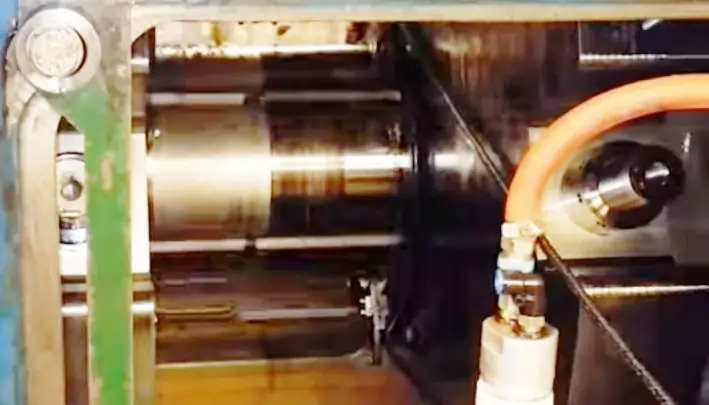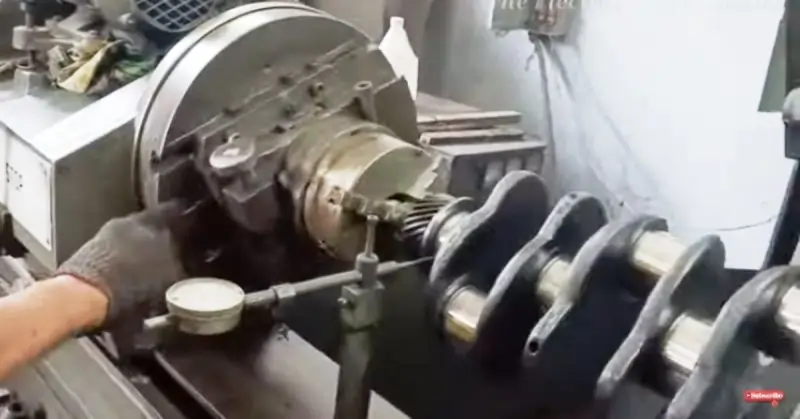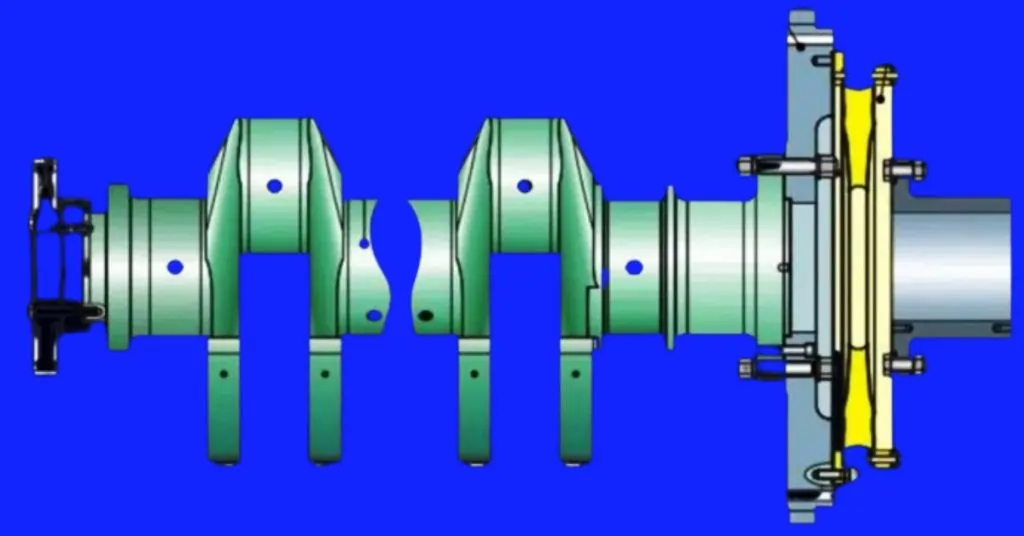Crankshafts
The crankshaft is a vital component in any engine, converting linear motion into rotational energy. Proper maintenance and repair of the crankshaft are crucial for ensuring optimal engine performance and longevity. Neglecting crankshaft care can lead to severe engine damage, costly repairs, and unexpected downtime. By implementing effective maintenance strategies, you can enhance the engine’s efficiency, reduce wear and tear, and extend its operational life.
In this blog post, we will explore seven powerful repair tips that every engineer should know. From regular inspections and proper lubrication to advanced techniques like in-situ grinding and polishing, we’ll cover all the essential practices to keep your crankshaft in top condition. We’ll also discuss how to address alignment issues, repair journal damage, and implement preventive maintenance strategies. Let’s dive into these expert tips to ensure your crankshaft performs at its best.
Regular Inspection and Diagnosis
Importance of Routine Crankshaft Inspections
Routine crankshaft inspections are critical for maintaining engine health and performance. Regular checks help identify early signs of wear and damage, preventing minor issues from escalating into major, costly repairs. Consistent inspections ensure that the crankshaft operates smoothly, reducing the risk of unexpected engine failures and extending the overall lifespan of the engine.
Tools and Techniques for Diagnosing Common Crankshaft Issues
To diagnose common crankshaft issues effectively, a range of specialized tools and techniques are essential. Dial indicators, micrometers, and crankshaft deflection gauges are crucial for measuring wear and alignment accurately. Advanced diagnostic tools like ultrasonic testers and magnetic particle inspection (MPI) devices can detect cracks and structural defects that are not visible to the naked eye. Utilizing these tools helps in pinpointing problems with precision, ensuring accurate assessments and targeted repairs.
Signs and Symptoms of Crankshaft Problems to Watch Out For
Being aware of the signs and symptoms of crankshaft problems is vital for early intervention. Common indicators include unusual engine noises such as knocking or grinding, excessive vibrations, and oil leaks around the crankshaft seals. Additionally, reduced engine performance, difficulty starting the engine, and visible damage or wear on the crankshaft surface are clear signs that an inspection is needed. Recognizing these symptoms early can help prevent further damage and maintain engine reliability.
Proper Lubrication
Role of Lubrication in Crankshaft Health
Lubrication plays a pivotal role in maintaining crankshaft health by reducing friction between moving parts, dissipating heat, and preventing metal-to-metal contact that can lead to wear and tear. Adequate lubrication ensures that the crankshaft operates smoothly, minimizing the risk of overheating and reducing stress on the engine components. This not only enhances performance but also significantly extends the lifespan of the crankshaft and the overall engine.
Types of Lubricants Best Suited for Crankshafts
Selecting the right type of lubricant is crucial for optimal crankshaft’s performance. High-quality engine oils with appropriate viscosity levels are essential. Synthetic oils, known for their superior stability and resistance to breakdown, are often preferred for high-performance and heavy-duty engines. Additionally, oils with specific additives, such as anti-wear agents, detergents, and corrosion inhibitors, provide extra protection and help maintain a clean and efficient lubrication system.
How to Properly Lubricate the Crankshaft to Prevent Wear and Tear
Proper lubrication of the crankshafts involves several key steps. First, ensure the engine oil level is maintained within the recommended range and regularly change the oil according to the manufacturer’s guidelines. Use a high-quality oil filter to remove contaminants that could compromise the lubrication quality. When applying oil, make sure it reaches all critical areas of the crankshaft, including the main and rod bearings. Regularly check for oil leaks and address any issues promptly to maintain consistent lubrication. Monitoring oil pressure and temperature can also help ensure that the crankshaft is receiving adequate lubrication at all times. By following these practices, you can effectively prevent wear and tear, ensuring the crankshaft’s long-term health and performance.
In-Situ Crankshaft Grinding

Explanation of In-Situ Crankshaft Grinding and Its Benefits
In-situ crankshaft grinding is a process where the crankshaft is repaired while still in the engine, without requiring disassembly and removal. This technique allows for precise grinding and polishing directly on the engine, making it a cost-effective and time-saving solution. The benefits of in-situ crankshaft grinding include minimized downtime, reduced labor costs, and the ability to quickly address damage and wear, ensuring the crankshaft returns to optimal performance standards without the need for extensive disassembly.
Step-by-Step Guide on How to Perform In-Situ Grinding
- Initial Assessment: Inspect the crankshaft to determine the extent of damage and identify the areas requiring grinding.
- Setup: Secure the grinding machine onto the engine block, ensuring it is properly aligned with the crankshaft.
- Preparation: Clean the crankshaft surface and surrounding areas to remove any debris or contaminants.
- Measurement: Use micrometers and dial indicators to measure the crankshaft’s dimensions and determine the required amount of material to be removed.
- Grinding: Begin the grinding process by slowly advancing the grinding tool to the crankshaft surface, applying even pressure to achieve a smooth and uniform finish.
- Polishing: After grinding, use polishing tools to achieve a fine, smooth surface on the crankshaft, reducing friction and improving performance.
- Final Inspection: Re-measure the crankshaft to ensure it meets the required specifications and check for any remaining imperfections.
Tools and Equipment Required for In-Situ Crankshaft Grinding
- Portable Grinding Machine: Specialized equipment designed for in-situ grinding, capable of precise and controlled material removal.
- Dial Indicators: Instruments used to measure the crankshaft’s dimensions and ensure accurate alignment.
- Micrometers: Precision tools for measuring the crankshaft’s diameter and roundness.
- Polishing Tools: Equipment such as polishing belts and pads to achieve a smooth and finished surface.
- Alignment Fixtures: Devices to ensure the grinding machine is correctly aligned with the crankshaft.
- Cooling and Lubrication Systems: To prevent overheating and ensure smooth operation during the grinding process.
- Safety Gear: Protective equipment for the technician, including gloves, goggles, and hearing protection.
By following this guide and using the appropriate tools, you can effectively perform in-situ crankshaft grinding, restoring the crankshaft to optimal condition and enhancing engine performance.
Crankshaft Polishing Techniques
Importance of Crankshaft Polishing for Smooth Operation
Crankshaft polishing is a critical step in engine maintenance, ensuring the crankshaft’s surface is smooth and free from imperfections. A polished crankshaft reduces friction and wear between moving parts, leading to smoother engine operation, improved efficiency, and extended component lifespan. Polishing also helps in preventing the buildup of contaminants and debris that can cause damage over time. Ultimately, maintaining a polished crankshaft ensures optimal performance and reliability of the engine.
Detailed Instructions on Various Polishing Techniques
- Hand Polishing
- Preparation: Clean the crankshaft thoroughly to remove any oil, grease, or debris.
- Polishing: Use a fine-grit emery cloth or sandpaper (typically 400 to 600 grit). Wrap the cloth around the journal and move it back and forth, applying even pressure.
- Finishing: Switch to a finer grit (800 to 1200) for the final polish, ensuring a mirror-like finish.
- Machine Polishing
- Setup: Secure the crankshaft in a polishing lathe or similar machine designed for crankshaft polishing.
- Polishing: Attach a polishing belt or pad to the machine. Start with a coarser grit and work your way to finer grits.
- Technique: Run the machine at a low speed initially, increasing the speed gradually while ensuring even coverage and pressure.
- Final Pass: Use a high-grit polishing belt for the final pass, achieving a high-quality, smooth finish.
- Chemical Polishing
- Preparation: Clean the crankshaft to remove all contaminants.
- Application: Apply a chemical polishing solution designed for crankshafts. Follow the manufacturer’s instructions regarding application and exposure time.
- Rinsing: Rinse the crankshaft thoroughly with water to remove any chemical residues.
- Final Polish: Use a fine polishing cloth to buff the surface, enhancing the smoothness and shine.
Recommended Tools and Materials for Effective Polishing
- Emery Cloth and Sandpaper: Fine-grit materials (400 to 1200 grit) for manual polishing.
- Polishing Lathe: A machine designed to hold and rotate the crankshaft for even polishing.
- Polishing Belts and Pads: Various grit levels to achieve the desired finish.
- Chemical Polishing Solutions: Specialized chemicals for enhancing the surface finish.
- Polishing Compounds: Abrasive compounds to be used with cloths or machines for a finer finish.
- Cleaning Agents: Degreasers and cleaners to prepare the crankshaft surface.
- Protective Gear: Gloves, goggles, and masks to ensure safety during the polishing process.
Addressing Crankshaft Alignment Issues

Common Causes of Crankshaft Misalignment Crankshaft misalignment can arise from several factors, each impacting the engine’s overall performance. Common causes include:
- Improper Installation: Incorrect assembly or installation of the crankshaft can lead to misalignment.
- Wear and Tear: Over time, bearings and other engine components may wear unevenly, causing the crankshaft to shift out of alignment.
- Engine Overheating: Excessive heat can cause metal components to expand and warp, resulting in misalignment.
- Impact Damage: Sudden shocks or impacts, such as those from collisions or dropped tools, can distort the crankshaft’s position.
- Manufacturing Defects: Occasionally, misalignment issues may stem from defects during the manufacturing process.
Methods to Check and Correct Crankshaft Alignment
- Visual Inspection
- Initial Check: Look for obvious signs of misalignment, such as uneven wear on bearings or unusual engine noises.
- Indicators: Check for oil leaks and excessive vibrations, which can also indicate misalignment.
- Dial Indicator Method
- Setup: Mount a dial indicator on a stable part of the engine block.
- Measurement: Rotate the crankshaft slowly and observe the dial indicator readings at various points along the crankshaft.
- Analysis: Compare readings to determine any deviations from the expected alignment. Deviations beyond the manufacturer’s specified tolerance indicate misalignment.
- Straightedge and Feeler Gauge Method
- Preparation: Clean the crankshaft and engine block thoroughly.
- Check: Place a straightedge along the crankshaft journals.
- Measurement: Use feeler gauges to measure any gaps between the straightedge and the journals. Gaps indicate misalignment.
- Correction Techniques
- Shimming: Adjust bearing caps with shims to correct minor misalignments.
- Line Boring: For severe misalignments, line boring the engine block can help restore proper alignment by machining the main bearing bores.
- Replacement: In cases of significant damage, replacing the crankshaft or associated components may be necessary.
Preventive Measures to Maintain Proper Alignment Over Time
- Regular Maintenance
- Routine Inspections: Conduct regular inspections of the crankshaft and bearings to detect early signs of misalignment.
- Lubrication: Ensure consistent and adequate lubrication to minimize wear and reduce the risk of misalignment.
- Proper Installation
- Precision Assembly: Follow manufacturer guidelines closely during assembly to ensure correct installation.
- Torque Specifications: Use a torque wrench to apply the correct torque to all bolts, preventing uneven pressure that can lead to misalignment.
- Temperature Management
- Cooling System Maintenance: Maintain the engine’s cooling system to prevent overheating, which can cause expansion and misalignment.
- Heat Shields: Use heat shields to protect the crankshaft and surrounding components from excessive heat.
- Shock Prevention
- Handle with Care: Avoid dropping or striking the crankshaft during maintenance and handling.
- Impact Protection: Use protective mats and equipment to cushion the crankshaft and other critical components during work.
Repairing Crankshaft Journal Damage
Identifying Crankshaft Journal Damage and Its Impact on Engine Performance Crankshaft journal damage is a critical issue that can significantly affect engine performance. Identifying this damage involves recognizing symptoms such as unusual engine noises (knocking or ticking), low oil pressure, and excessive vibrations. Visual inspection might reveal scoring, pitting, or uneven wear on the journal surfaces. These damages can lead to poor lubrication, increased friction, and eventual bearing failure, resulting in reduced engine efficiency, overheating, and potential catastrophic engine failure if not addressed promptly.
Techniques for Repairing Damaged Crankshaft Journals
- Grinding and Polishing
- Assessment: Measure the journals to determine the extent of damage and required material removal.
- Grinding: Use a crankshaft grinding machine to remove damaged material and restore the journal to the correct size and roundness.
- Polishing: Follow up with polishing to achieve a smooth surface, enhancing oil film formation and reducing friction.
- Hard Chroming
- Preparation: Clean the damaged journal and mask off adjacent areas.
- Plating: Apply a layer of hard chrome to the journal surface to restore its diameter and provide a durable, wear-resistant finish.
- Finishing: Grind and polish the chromed journal to achieve the desired surface finish and ensure proper fitment.
- Metal Spraying
- Preparation: Clean the journal and apply a bonding agent.
- Spraying: Use a metal spraying gun to apply a layer of molten metal to the damaged area.
- Machining: Grind and polish the sprayed journal to restore the original dimensions and surface quality.
- Sleeving
- Preparation: Machine the damaged journal to create a smooth, undersized surface.
- Installation: Press-fit a custom-made sleeve onto the machined journal.
- Finishing: Grind and polish the sleeved journal to achieve the correct dimensions and surface finish.
Best Practices for Preventing Future Journal Damage
- Regular Maintenance
- Routine Inspections: Conduct regular inspections of the crankshaft and journals to detect early signs of wear or damage.
- Timely Oil Changes: Follow manufacturer guidelines for oil change intervals to ensure proper lubrication and prevent contamination-related wear.
- Proper Lubrication
- High-Quality Oils: Use high-quality, manufacturer-recommended engine oils with appropriate viscosity and additives.
- Oil Filtration: Maintain the oil filtration system to prevent debris and contaminants from damaging the journals.
- Accurate Assembly and Installation
- Torque Specifications: Follow precise torque specifications during assembly to avoid uneven pressure on the journals.
- Cleanliness: Ensure all components are thoroughly cleaned before installation to prevent abrasive particles from causing damage.
- Temperature Management
- Cooling System Maintenance: Keep the engine’s cooling system in optimal condition to prevent overheating and thermal expansion of the crankshaft.
- Heat Dissipation: Use proper engine operating procedures to allow gradual warming up and cooling down, minimizing thermal stress on the journals.
- Impact Protection
- Handling Care: Handle the crankshaft and related components with care during maintenance and repairs to avoid accidental damage.
- Protective Measures: Implement protective measures in the engine environment to shield the crankshaft from external impacts and debris.
Preventive Maintenance Strategies
Comprehensive Tips for Extending the Life of the Crankshaft Ensuring the longevity of your crankshaft requires a proactive approach to maintenance. Key strategies include maintaining optimal lubrication, monitoring engine performance, and adhering to a regular maintenance schedule. Using high-quality lubricants and changing them at recommended intervals prevents wear and reduces friction. Regularly inspecting the crankshaft and related components allows for early detection of potential issues, ensuring timely repairs. Additionally, avoiding engine overload and maintaining proper operating temperatures help minimize stress on the crankshaft, thereby extending its service life.
Routine Maintenance Tasks to Include in Your Engine Care Regimen
- Lubrication Checks
- Oil Levels: Regularly check and maintain proper oil levels to ensure sufficient lubrication.
- Oil Quality: Periodically test the oil for contamination and degradation, replacing it as necessary.
- Visual Inspections
- Surface Inspection: Examine the crankshaft for signs of wear, cracks, or scoring.
- Bearing Condition: Inspect the bearings for uneven wear or damage, replacing them if needed.
- Vibration Analysis
- Monitoring: Use vibration analysis tools to detect abnormal vibrations that could indicate alignment issues or wear.
- Assessment: Address any abnormalities promptly to prevent further damage.
- Temperature Monitoring
- Coolant Levels: Ensure the cooling system is functioning correctly and maintain proper coolant levels.
- Temperature Checks: Regularly monitor engine temperatures to prevent overheating.
- Alignment Checks
- Periodic Alignment: Check and correct crankshaft alignment during routine maintenance to prevent misalignment-related issues.
- Component Maintenance
- Seal and Gasket Inspection: Regularly inspect and replace seals and gaskets to prevent leaks and contamination.
- Timing Belt/Chain Inspection: Ensure the timing belt or chain is in good condition and properly tensioned.
Importance of Keeping Accurate Maintenance Records Maintaining accurate and detailed maintenance records is crucial for effective preventive maintenance. These records provide a history of inspections, repairs, and replacements, allowing you to track the condition of the crankshaft and identify patterns of wear or recurring issues. Accurate records help in scheduling timely maintenance tasks and making informed decisions about component replacements. They also provide valuable information for troubleshooting and can enhance the resale value of the engine by demonstrating a well-documented maintenance history. In commercial operations, these records ensure compliance with industry standards and regulations, supporting operational efficiency and safety.
FAQ on “Crankshafts”
Q: What is the primary function of a crankshaft?
A: The crankshaft converts linear motion of the pistons into rotational motion to power the engine.
Q: How can I identify crankshaft damage?
A: Look for unusual noises, vibrations, low oil pressure, and visual signs of wear or scoring.
Q: What are common causes of crankshaft misalignment?
A: Misalignment can be caused by improper installation, wear and tear, overheating, and impact damage.
Q: How often should I inspect my crankshaft?
A: Regular inspections should be part of your routine maintenance, ideally every oil change or every 500 hours of operation.
Conclusion
Maintaining a healthy crankshaft is essential for ensuring optimal engine performance and longevity. By implementing regular inspections, ensuring proper lubrication, and addressing alignment issues promptly, you can prevent significant damage and costly repairs. Techniques like in-situ grinding, polishing, and repairing journal damage are crucial for restoring and maintaining crankshaft health. Moreover, adhering to a comprehensive preventive maintenance regimen and keeping accurate records will help extend the life of your crankshaft, ensuring reliable and efficient engine operation. By following these seven powerful repair tips, you can maximize your engine’s performance and durability.
